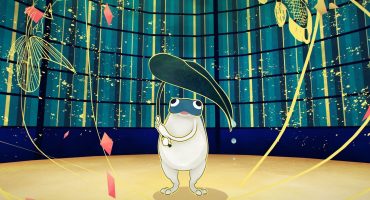About
My name is Nick Ladd and I’m a Canadian VR artist and animator. All of my recent work is done in Virtual Reality using an Oculus Rift with software such as Quill and AnimVR. I have studied both 3D Animation and 2D Illustration and have found that VR tools are a perfect bridge between the two. With VR it’s possible to create expressive 3D models that recapture the hand-made feeling that’s often lost in 3D design.
Inspiration
This piece “the Magus” is a recreation of a tarot card design by artist/animator Joe Sparrow. His designs are very flat and graphic so I tried to reproduce that in VR as well as I possibly could. I saw this as an opportunity to experiment with some new techniques and push Quill for some nice clean results. This piece, along with its animations, were completed in one day over about 4-5 hours. Joe’s work can be found here.
The Process in Quill
For those who have never painted in VR it’s sort of like a mix of drawing and sculpting. You work in a virtual environment of near-infinite scale and you can work all around you. Everything in Quill is a stroke extruded along a curve, you make these strokes using a variety of brushes and can later reshape and recolour them by nudging and painting the vertices.
- Nudge Tool
- Brush Tool
- Recolour Tool (Dodge)
There’s no lighting in Quill which makes it perfect for creating flat/graphic designs and linework while also making it feel a lot less like sculpting/modelling and a lot more like drawing and painting. When you export files from Quill and add some lighting you see just how messy they really are. Every VR painting is made up of thousands of individual pieces of tube mesh, giving an incredible illusion that only works when the lighting is off.
For creating the tarot card I first imported an image of the original design into Quill and aligned it to the grid. I blocked out the big shapes like the head, the hat, etc., and compared them directly to the reference, often overlaying them to make sure the proportions were correct. Creating complex shapes like spheres and cones in Quill isn’t as simple as a button press like it is in every other 3D software. Because everything in Quill is strokes and tubes, creating a perfect sphere isn’t very straightforward. To get a sphere you have to first start by drawing a circle and then duplicate/revolve that circle around an axis. What’s good about this approach is that it creates a lot of vertices that you can grab and sculpt into all sorts of shapes. I used this technique for most of the big organic volumes like the head and body. If you look at the wireframe you’ll see lots of weird tube shapes.
Something that Quill excels at is creating lineart. You can create thick or thin strokes based on how much pressure you apply to the trigger. All of the lines on this model were redrawn by hand based on the reference. Like other digital art tools I always try to get the lines perfect in one clean stroke but I usually have to make small adjustments with the nudge tool. The lines are geometry and not done using a toons shader, which means that if you look at the model from the wrong angle the illusion completely breaks. This is why I opted to lock the camera angle on this model; Camera Limits is a useful Sketchfab feature that helps better showcase this project.
One of the advantages of the flat shaded look is how much you can hide. In this piece the area around the card is actually in a black box, but because the box is the same colour as the background it completely disappears and makes it look like the card is a hole in empty space.
Quill is also a great animation tool. It’s entirely frame-by-frame with no interpolation or rigs. You animate by moving the strokes each frame, and you can also modify then by nudging them around. Whenever you move the strokes you see the onion skin like you would in 2D animation only in 3D… in this way VR animating is a bit like 2D animation mixed with stop motion. It’s very flexible and I’ve using a lot of old-school 2D animation techniques like smear frames, inbetweens and timing charts. You can also animate while the animation is playing. If you grab areas on the model you can puppet them while the scene is playing or use the brush tool to create animated strokes (like the trail on the magic wand).
Sketchfab has been the perfect companion site for my VR works and it’s the first website that I link to whenever I want people to check out my stuff. Many of my Quillustrations are their own little worlds; pictures and videos do not do them justice. Sketchfab is a great tool for displaying these projects because it allows people to explore my scenes freely. These pieces were made in VR and VR will always be the best place to view them. Sketchfab provides an easy way for people to explore the models both in and out of VR and has been a big source of clients for freelance projects.
Vimeo / Artstation / Joe Sparrow’s Twitter / Joe Sparrow’s Shop









